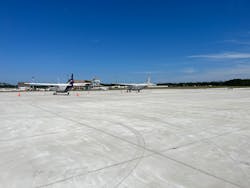Long-Life Airport Pavements Set a Standard for Sustainable Infrastructure
Considerations of sustainability and resilience are coming to dominate conversations around transportation infrastructure, especially as an increase in federal funding brings new opportunities to the industry. For airports, the FAA has been committed for more than a decade to achieving sustainability and cost goals through life cycle planning. As part of its Extended Airport Pavement Life program, the Administration intends to double the expected life of runways at large hub airports, going from 20 years to 40 years. The program funds research to determine and implement optimal pavement design, construction, maintenance and rehabilitation methods.
During early phases of the extended pavement life program, data was collected on pavement performance with a goal of identifying factors that would extend service life. Testing was performed using pavement condition index (PCI) assessments, conducted in accordance with ASTM D5340. A 2014 FAA report, “Performance Trends in Airport Runway Pavements,” by Hall et al., presented PCI data for both asphalt and concrete pavements located across 18 large airports and concluded that asphalt pavements “generally deteriorate to a PCI of 70 within approximately 12 to 15 years, requiring a new surface to reinstate them to a PCI of 100…[while] portland cement concrete (PCC) pavement [is] nearly 40 years of age before a PCI of 70 is reached.”
Resilience in infrastructure—defined as its ability to recover after a disruptive event—is a factor in sustainability. Resilient systems reduce future reconstruction costs as well as future societal costs associated with not being able to use the infrastructure during rescue, recovery and rebuilding. The vital role of resilience is highlighted by research performed in Portland, Ore., an area of the globe where designing in resilience includes considering seismic events. A study conducted by the Multi-Hazard Mitigation Council of the National Institute of Building Sciences, titled “Mitigation Saves: A Resilient Runway at Portland International Airport Could Save Up to $50 for Every Mitigation Dollar Invested,” determined that installing a seismically-resilient runway at Portland International Airport (PDX) would provide a cost-to-benefit ratio of 50-to-one. For the health and medical category alone, researchers concluded that a resilient runway could achieve $460 million in benefits, a savings realized through the ability to use PDX for medical evacuation. Additional benefits would be associated with speeding the re-occupancy of homes and businesses. As of early 2022, the Port of Portland was beginning its seismic upgrade by assessing soil liquefaction in the area surrounding PDX.
"High Water Table or Flood-Prone Airfield Pavements: Charleston Executive Case Study," by Greg Dean, Executive Director, American Concrete Pavement Association—Southeast Chapter, examines the effect of flooding events on pavement resilience. The presentation identifies two main considerations: first, the ways in which flooding reduces a pavement's ability to carry loads and second, the recovery time it takes for the pavement to return to a serviceable condition. Concrete outperforms asphalt on both points. Rigid concrete pavements distribute loads over a larger area than asphalt pavements. They also experience only minor deflection and rely minimally on subgrade base strength. This means flooding does not affect concrete's load-carrying capacity as severely as it affects that of asphalt. Furthermore, because stiffer pavements are less impacted by subgrade strength loss, concrete pavements suffer less long-term deterioration attributable to supersaturated subgrades and are therefore better able to maintain their original life expectancy following a flooding event.
For airport pavements in need of repair, concrete overlays can provide an excellent solution. Installing an overlay increases the height of the pavement, helping raise its elevation above the water table, and also increases the structural strength of the pavement. Charleston Executive airport (JZI), located in the "low country" of Johns Island, S.C., installed an 11-inch unbonded concrete overlay in 2010. Existing pavements consisted of a concrete runway that had been in service for 60+ years, as well as a section of asphalt. As of 2016, the six-year-old concrete overlay was still performing well, according to Dean, with deterioration rates less than similarly-aged asphalt and asphalt overlays. In general, asphalt pavements deteriorate at rate of 1.5 to 2.5 PCI points per year--an average of 2 points--whereas concrete pavements only deteriorate at rate of 0.5 to 1.2 PCI points per year.
The world’s busiest airport, Hartsfield-Jackson Atlanta International Airport (ATL), is in the midst of a 20-year capital improvement program known as ATLNext. Sustainability is a key focus of the program, which includes repaving as well as construction of a new taxiway. Fortunately, ATL already had a history of pavements achieving life spans longer than the accepted 20 years. A 2013 assessment by Greer, et al., titled “Design, Construction and Maintenance of Concrete Pavements at the World’s Busiest Airport,” indicated that ATL’s two main departure runways, which are constructed of concrete, had “served almost double their original design lives with each serving more than 5 million departures.” One of the runways (RW-8R) had been replaced in 2006 at an age of 37 years. The second runway (RW-9L), at 38 years old, was still in service at the time of the 2013 report and was expected to serve several more years. Steps taken by ATL to prolong pavement life were cited by the paper’s authors to include innovations in joint design, dowel placement, and slab geometry, along with the use of subsurface underdrains. Also critical to the success of the runways was the use of a pavement management system (PMS) to evaluate and maintain the pavements. ATL implemented these same innovations during later pavement construction projects and they have also been used at other airports to achieve similar improvements in longevity, according to the paper’s authors. Since the time of the publication, some concrete replacement has occurred at ATL, but no full-width concrete runway pavement replacement has been required.
“Contributing to long pavement life at ATL are the use of annual airfield pavement repair contracts, as well as the use of Class F fly ash to address alkali-silica reactivity,” said Quintin Watkins, Vice President - Office Executive, Michael Baker International.
In 2019, the John F. Kennedy International Airport in New York City reconstructed runway 13L-31R—one of the airport’s four runways and one that receives one-third of the airport’s arrivals—using concrete as an alternative to asphalt. A press release from The Port Authority of New York and New Jersey noted that the concrete runway is expected to provide “long-term durability that will minimize future operational impacts and meet current Federal Aviation Administration (FAA) design standards. The concrete application has a 40-year lifespan, four times longer than the previous asphalt paving.” Pavement work performed as part of the project included widening the runway by 50 feet to accommodate the large aircraft that frequent the airport.
While large airports reap the economies of scale associated with concrete pavement’s benefits, small airports are also taking life cycle into consideration when designing for resilience, sustainability and cost-effectiveness.
The Dare County Regional Airport (MQI), located on Roanoke Island in the Outer Banks area of N.C., replaced its apron in 2021-22. The existing concrete pavement had been in service for nearly 80 years and by 2021 was seeing more than 32,000 landings and takeoffs each year. Because of concrete’s expected life span—75-to-80 years as opposed to asphalt's 20-25 years—the airport authority chose concrete pavement for the new apron. Construction entailed full depth removal of the existing concrete and replacement with 15,700 square yards of new concrete, constructed to a depth of 8.5 inches.
Runway 17/35 at the North Platte Regional Airport (LBF) in North Platte, Neb. received an eight-inch concrete overlay in 2011. Existing pavement consisted of 70-year-old concrete overlaid with four- to 12 inches of asphalt. The design and engineering team considered several options for the runway’s repair, but because of the runway’s proximity to the Platte River and the heaving associated with the area’s high water table, chose concrete overlay as the best solution. Dowels were installed in the concrete pavement joints to further resist heaving. The cost of the overlay was less than half the cost of complete reconstruction. North Platte also used concrete during an expansion of its main aircraft apron. For this project, the existing 26,000-square-yard apron was overlaid with eight inches of unbonded concrete while the 21,800-square-yard expansion was constructed of 10-inch concrete.
As the FAA points out, extended pavement life has benefits beyond sustainability and resilience. It saves taxpayer dollars and reduces delays associated with pavement reconstruction. It also allows airports to serve a greater number of passengers. Comprehensive concerns such as these are increasingly factored in as airport authorities plan for the future. Looking back at pavements that have stood the test of time, it becomes clear that the most sustainable product is one that doesn’t need to be replaced or repaired frequently.
Kristin Dispenza has been a member of the AOE team since 2013, developing trends articles, case studies and other PR materials. She received a Bachelor of Science degree from The Ohio State University College of Engineering/School of Architecture and has more than 25 years of writing and editorial experience.






